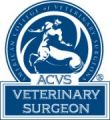
Extensive surgical expertise coupled with cutting-edge equipment and technology allow us to provide pets with the highest level of care. The board-certified small animal surgeons at AESC diagnose and treat a wide variety of illnesses and injuries, from soft tissue procedures like tumor removal and laryngeal paralysis correction to orthopedic procedures like TPLO and fracture repair. Our surgeons have advanced equipment and dedicated surgical suites at their fingertips for a safe, effective surgery with minimally invasive options available for certain procedures. We also have surgeons on call 24/7 should your pet experience an emergency that requires immediate intervention.
Minimally Invasive
When a minimally invasive technique is elected, our surgeons evaluate and repair damaged tissues using an incision only about ½” in size—just large enough for a small camera and instruments to be inserted. These innovative techniques result in less pain and a faster recovery time.
Orthopedic Surgery
Thoracic Surgery including minimally invasive thoracoscopy to remove tumors, treat vascular ring anomalies, create pericardial windows, ligate the thoracic duct and treat PDA anomalies
Abdominal Surgery including minimally invasive laparoscopy to perform prophylactic gastropexies, tissue biopsies, feeding tube placement, cryptorchid castrations, laparoscopic spays, cholecystectomies, and abdominal lavage for pancreatitis, gastrointestinal surgery (including liver shunts) and urogenital surgery
Neurosurgery is the medical specialty that deals with the prevention, diagnosis, surgical treatment, and rehabilitation of disorders which affect any portion of the nervous system including the brain, spinal cord, peripheral nerves, skull, and vertebral column. Surgical procedures include spinal fracture/luxation reduction and stabilization, hemilaminectomy, ventral slot, dorsal laminectomy, Atlanto-occipital luxation stabilization, cancer resection or debulking.
Oncologic Surgery includes surgical management of tumors, especially cancerous tumors. We provide comprehensive treatment of cancer in combination with the oncology department. Surgical procedures include resection of skin and subcutaneous tumors, maxillofacial tumors, thoracic tumors and abdominal tumors.
Skin & Reconstructive Surgery includes the management of traumatic wounds, burns and large skin defects with vacuum assisted closure, skin flaps and skin grafts. Reconstructive skin grafts and flaps are what's used to treat serious injuries to the body's skin, usually following surgical removal of damaged skin.
What is a Board-Certified Veterinary Anesthesiologist?
A board-certified specialist in veterinary anesthesia and analgesia® is a veterinarian who has undergone four years of advanced training beyond veterinary school and passed an intensive specialty examination. This rigorous background allows the board-certified anesthesiologist to successfully assess and mitigate anesthetic risk for patients such as brachycephalics, geriatrics, and those with heart, kidney, and hormonal diseases.
Minimizing Anesthetic Risk
With individualized drug protocols and attentive monitoring, our team works to minimize the inherent risk that anesthesia carries. Before your pet has surgery, our board-certified anesthesiologist carefully reviews your pet’s medical record and evaluates your pet’s heart and lungs. This allows for every anesthetic protocol to be customized to each pet. Even if your pet has a preexisting condition, such as heart disease, the safest possible medications are used.
Our dedicated surgery nurses are overseen by the anesthesiologist as they thoroughly monitor your pet while anesthetized. Our state-of-the-art equipment includes: capnography; pulse oximetry; electrocardiogram; blood pressure (oscillometric and direct); and temperature monitoring. We monitor and stay attuned to your pet throughout the entire anesthetic event, ready to intervene at the first sign of any potential complication.
Your Pet’s Comfort
While our anesthetic protocols are unique to each pet, locoregional anesthesia is integral to most pets’ surgeries here at AESC. By numbing the area of the body where surgery occurs, we reduce the amount of gas anesthesia and opioids necessary to keep your pet comfortable. This technique allows pets to wake up from anesthesia more like themselves – less sedate and oftentimes with a hearty appetite!
It is important that all aspects of your pet’s comfort are considered during the hospital stay. For anxious pets, we administer gentle sedative medications so that they can rest comfortably both before and after their surgical procedure.
